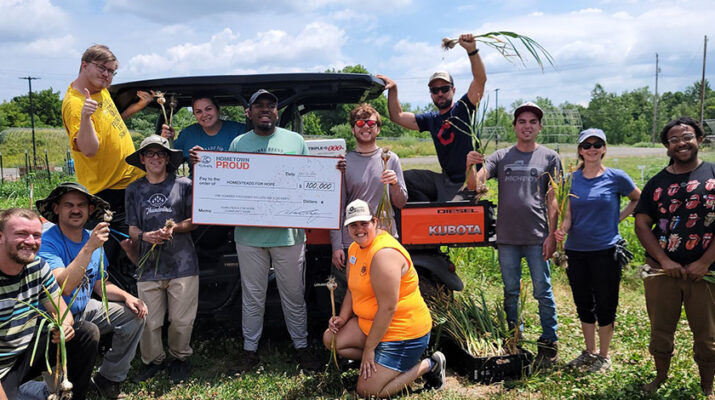By John Addyman
Homesteads for Hope, a nonprofit community farm for people of all abilities, recently received a major grant from Kubota Tractor Corp. One of the plans is to create an inclusive housing village that will give 250-plus people a place to call home
Jennyrae Brongo describes herself as a “sister to autism,” because she grew up with her brother, Chucky, who has profound needs.
When the school bus stopped coming, so did many of the services Chucky relied on.
As his sole guardian, Brongo embraced the big sister role, then extended it to others in the special-needs community by creating Homesteads for Hope in 2013, a nonprofit community farm for people of all abilities.
“I came to terms with the fact that I would have to create something for my brother, and now this is so much bigger than just us,” she said.
With fundraising, good advice from experts nationwide, and hundreds of volunteers, Brongo purchased her great uncle’s 55-acre farm with 3,000 linear feet of frontage on the Erie Canal in Spencerport in 2016. It was perfect timing — viable options for people with special needs are even more scarce today.
That farm is the locus of a three-phase plan Brongo developed. The farm continues to grow and is safe haven for many who have been displaced from more traditional options.
In Good Health recently interviewed Homesteads for Hope’s founder Brongo and Heather Burroughs, the organization’s grants and media director.
Q: Describe the first two phases of your plan.
A: We wanted to create a community farm of acceptance where people with disabilities and their families could feel hopeful again. Phase one and two are all about growing what people can do. We have created various programs and enterprises on the farm that encourage everyone to learn, grow and socialize. We get them off the couch and into nature’s classroom, where they make friends, learn skills, and are empowered to dream up a new kind of life for themselves.
Q: The third phase is the most ambitious, what do you have in mind?
A: We will use our 30 remaining acres to create an inclusive housing village that will give 250-plus people a place to call home. With group homes closing at an alarming rate, many people are very concerned. Our ability to be self-sustaining and be around for generations to come lies in the enterprises in our first two phases. We are not skipping steps or cutting corners. With a strong foundation, we will be able to provide solutions that help address the housing crisis in the special-needs community.
Q: What does Homesteads for Hope offer today as a farming enterprise?
A: We grow more than produce. We grow hope and show people what true inclusion looks like. The learning opportunities for people with disabilities out in the fields and in our farm store are not “busy work.” Their hard work helps feed nearly 200 families who are part of our subscription community-supported agriculture program, and the many more that visit our store. We have over 3,000 visitors each year who enjoy listening to music, hosting events and exploring our canal-side property. People come here knowing the money they spend at our store, café or grill supports our mission. We have memberships that offer perks like garden boxes, U-pick options and discounted barn rentals for private events. We are currently raising funds to complete our Forever Homestead, which will transform our 200-year-old estate home into a learning and enrichment center able to serve people year-round.
Q: How many people are involved in your programs, which are designed for those who have disabilities as well as people who don’t? How many employees do you have? How many volunteers?
A: Our intentional agriculture community currently serves over 600 families, but our dreams have outgrown our current setup and we stand by our promise to triple our impact and welcome more families to Homesteads. Many team members and volunteers have personal connections to the special-needs community. With around 13 full-time staff and 30 regular volunteers, we make magic happen. Imagine what we can do when can hire more staff!
Q: Homesteads for Hope has been blessed with in-kind and financial donations. How will monetary gifts be used? What in-kind help do you need?

A: Your dollars will go to something you can see that creates a valuable and needed resource for our community, like our Forever Homestead. With donations, we’ll make our campus accessible to all physical abilities, create a recreational learning trail, renovate our historic barns, and redesign our raised garden beds to better serve our members with more profound needs. We appreciate people who set up regular monthly donations, no matter the size, because that helps sustain us through the winter season, when we cannot grow and sell produce. Contractors willing to donate labor or materials for any of our projects are invaluable, especially given what inflation has done to costs.
Q: You recently won a $200,000 grant from Kubota Tractor. Where will that be put to use?
A: This funding will help us expand our social garden program for those with more challenging needs and mobility-based disabilities, double our 80-plot community garden, and help us renovate the estate home, with materials like a tile backsplash kitchen, to weatherproof the main program spaces. It will also allow us to upgrade our historic barns and continue to pour new concrete pathways to increase accessibility.
Q: What does your brother Chucky think about plans for Homesteads’ future?
A: I would like to think Chucky understands our mission and all that will unfold in the years to come. Every time he is here, Chucky is smiling and doing things that are not possible when he is not here. The outside world is not made for him – this community is…and he feels that. Everyone does.

